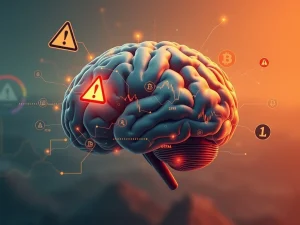AI Funding Surge: Unpacking the Exciting Future of Crypto and Digital Assets

The world of digital assets is buzzing with a powerful new convergence: artificial intelligence meeting blockchain technology. This isn’t just theoretical; it’s leading to a significant “AI money rush” that has the potential to fundamentally reshape the crypto industry as we know it. Industry leaders and global forums alike are highlighting the increasing synergy, suggesting AI and blockchain together will augment our digital experiences and interactions.
Exploring the Landscape of AI Funding
The rush for AI funding has become a dominant theme in the tech world, attracting massive venture capital flows. At a recent major tech conference, I moderated a panel on AI venture capital, exploring the forces driving this rapid investment surge. The discussion revealed that while generative AI has seen explosive growth, investors are keenly watching foundational AI infrastructure and specific use cases.
While crypto wasn’t the direct topic, the trends discussed by leading VCs offer valuable insights into where innovation is headed, and how it might intersect with blockchain technology. A key takeaway is the sheer scale of AI investment compared to other sectors, including digital assets.
Comparing AI vs. Crypto Venture Capital
Data clearly shows where venture capital has been flowing recently. The numbers from Q1 2024 paint a stark picture:
- **AI Startups:** Attracted nearly 60% of global venture capital.
- **Total AI Funding Q1 2024:** Approximately $73 billion globally.
- **Notable AI Funding:** $40 billion came from a single round for OpenAI.
- **Crypto & Blockchain Startups:** Amassed around $4.8 billion in Q1 2024 funding.
This significant difference highlights the current investor focus. While crypto venture capital remains substantial, the AI funding landscape is currently outpacing it significantly. This dynamic underscores the importance for the crypto industry to understand and integrate AI trends to stay competitive and attract future investment.
The Rise of AI Native Finance
One fascinating area of convergence is the concept of “AI native finance.” Sean Neville, co-founder of Circle, a major stablecoin issuer, is pioneering this with his new venture, Catena Labs. Backed by a significant $18 million funding round led by a prominent crypto venture capital firm, Catena Labs aims to build a regulated financial institution specifically designed for an AI-driven economy.
The core idea? That AI agents will soon perform most economic transactions. Catena Labs believes traditional financial systems are ill-equipped to handle this shift. This vision of AI agents operating within a dedicated financial framework built with modern technology, potentially leveraging blockchain technology for settlement or transparency, represents a significant evolution in how we think about automated finance.
Decentralized AI Built on Blockchain Technology
Beyond finance, the push for decentralized AI is gaining traction, directly leveraging blockchain technology’s strengths. Nous Research recently secured a substantial $50 million in funding, valuing the company at $1 billion, to build decentralized AI models on the Solana blockchain.
Instead of training large language models (LLMs) in traditional, centralized data centers, Nous is developing a community-driven, open-source approach on Solana. This uses the blockchain to incentivize user participation in the development and training process. This decentralized model offers an alternative to the current dominance of centralized AI labs and aligns closely with the core principles of the blockchain and crypto space.
Why This Matters for Crypto Venture Capital and the Industry
The intense focus and funding flowing into AI are not happening in a vacuum relative to crypto. These trends are directly influencing the types of projects receiving crypto venture capital and shaping the future use cases for blockchain technology. Investors are looking for synergies, projects that leverage AI for better efficiency, new decentralized applications, or novel forms of digital ownership and interaction.
The competition for talent and investment is real, but the potential for collaboration and innovation is even greater. Projects like Catena Labs and Nous Research demonstrate that the crypto industry isn’t just watching the AI rush; it’s actively building the infrastructure and applications for an AI-integrated digital future.
Conclusion: Reshaping the Digital Asset Landscape
The “AI money rush” is more than just a temporary trend; it’s a powerful force driving innovation at the intersection of AI and blockchain. While AI funding currently dwarfs crypto venture capital, the developments in AI-native finance and decentralized AI on blockchain platforms show promising paths for convergence. These efforts highlight how blockchain technology can provide the decentralized, transparent, and programmable layers needed for an AI-driven economy. As AI capabilities advance, its integration with digital assets is set to profoundly reshape the crypto industry, creating new opportunities and challenges for builders, investors, and users alike.









